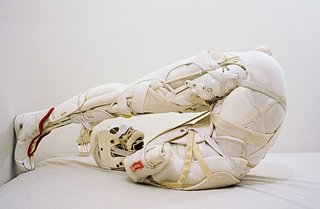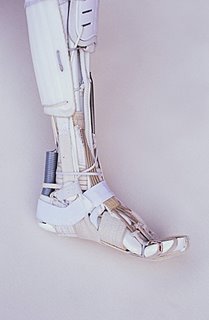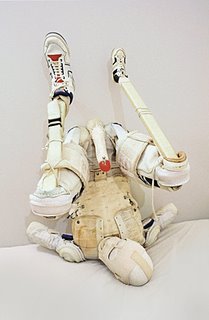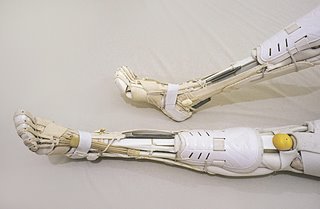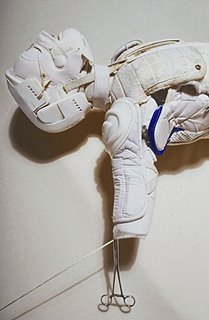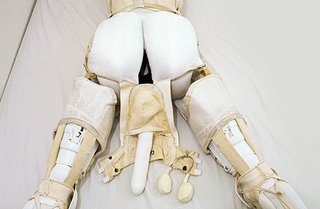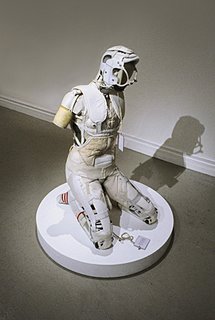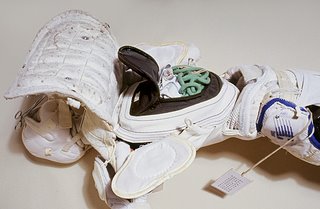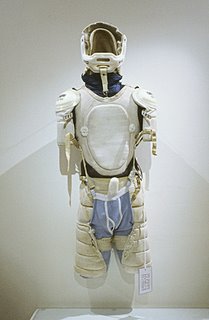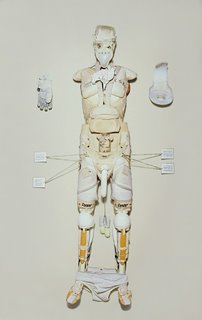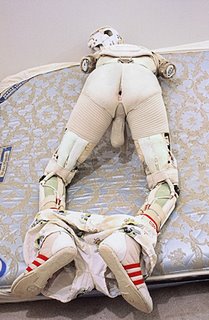
Anatomy, Pathology and Perception
LIFE-SIZE BODY SCULPTURES BY ARTIST ROGER GREMO
The Body and "Memories of Underdevelopment"
LIFE-SIZE BODY SCULPTURES BY ARTIST ROGER GREMO
The Body and "Memories of Underdevelopment"
These life-size figurative / representational / conceptual / articulating / interactive soft sculptures made from used clothing / hand sewn with supplementary dialogue are a reflection of the artist’s search for affinity between human sexuality, truth and functionality in regards to human development.
I refer to my art as being psycho sexual in its concept ... a clinical term that generally suggests pathology. My concerns deal with mechanisms of perception and how we perceive the body, presenting a critical challenge to social ‘understanding and misunderstanding’ that surround our bodies and how we vent desire ... to the extent that perceptions of pathology are perpetuated by such mechanisms.
My own history is one of having a sense of gender identity in my early youth, but at the same time of not having accessibility or the occasion to understand that. Conflicts with what appeared to be a not fully developed social consensus were all around. There is a history of repression, of a constrained self-understanding and of a secret life. It is not my intention to dwell upon this. However it is this history that gave me cause to ask the questions in the beginning that ultimately influenced my making art. These sculptures are, as such, part autobiographical and part social commentary in that they articulate these ‘memories of underdevelopment’.
Insofar as psychopathology derives itself from such binds, and insofar as the question here is ‘not whether one is psycho-sexually pathologic’, but rather ‘what is one’s psycho-sexual pathology’. Then the intimate details of the sculptures will resonate beyond the auto biographical.
...
It is obvious that sexual behaviour is a primary force in our lives, that contemporary society has achieved much sexual freedom and that our knowledge of real human sexuality is more considerable then ever. We find and rely on humour in our ever expanding sexual smorgasbord that has become our outward collective sexual identity ... albeit, a sexual identity that is still defined differently in public than it is in private.
A coating of safe pretense disguises the public presentation of sex while in private we secretly relish and find affinity with the reality of it. Those behaviours we qualify publicly as aberrant are often the same behaviours we practice in private. Here, the fine line between pretense and real makes it difficult to judge ‘normal’ from ‘abnormal’.
We feel smug in the pretense of our understanding. In regards to real psycho sexual pathologic behaviour, one might say we still don’t have the question let alone the answer.
We intellectualize the dynamics of fulfilling our desires. We point to society’s historical edicts, whether progressive or not, that have influenced our sexual identity or consensus and find solace that perhaps sexual freedom has arrived. We are prone to over simplifying and apply our personal histories as reference points.
In our propensity to qualify, categorize and judge we are constantly shifting forwards and backwards in our efforts to place sexual behaviour where we think it will no longer be an issue of serious concern ... but alas ... we are personally involved and have bias. Our individual sexual proclivities become the true standard.
Are we deprived? Are we depraved? We are embarrassed and angry. Do we really comprehend the nature of pathology in its acceptance or denial?
With all this, the nitty-gritty aspects of what we perceive as psycho sexual pathology, still make us nervous. As such, I invite the viewer to be both victim and instigator through the hands on / exploratory aspects of the sculpture.
...
Surgery of the Body Desire
This work moves through as many as three stages. First perception, then reaction and finally action. For some viewers, these sculptures could remain a viewing experience only. Depending on the reaction to the prospect being close, touching and physically exploring and manipulating the sculptures, the installation could become equally participatory.
To different viewers the sculptures will introduce different barriers and thresholds. For those challenged or repulsed by the specifically male body the conflict with their own body concept and gender identity will set the parameters of the work experience. It will be a visual experience. It may involve issues of pornography, of raw and unembarrassed utilization of the body as a sexual tool and toy. The terrain here is moral as if to deny present morality clauses themselves. As the work does nothing but give permission, it implicitly argues a tolerance or even an unconditional acceptance concerning the ways we vent desire. A moment of accessibility to conflicts born of subjectivity and consensus is made.
For those whom the body type is not a barrier, it becomes an approachable artifact, indeed, something which invites hands on exploration. We become like ‘surgeons of the body desire’. My work explorations with cadavers at The University of Toronto Medical Facilities has added much to my appreciation of the physical world and the physiological / psychological body and the body politics applied. Literally, wearing surgical gloves, we can interact physically by opening the sculpture body up and encounter objects that are both artifact and organ. Furthermore, we are tempted to leave the reflexive or distanced relation to the work, and to exploit the sculptures. They are in fact functional anatomically as sexual dolls, something that only becomes clear up close, by manipulation.
The closer one comes to the sculptures, the more topical they become. The materials used in the sculptures have memories... desire memories that are fetishistic and scientific. They suggest ‘function and disfunction’. Each sculpture takes on an obsessive quality; the detail in the stitching, the endless storage areas built into the weight, heft and size of the body structure where one may find fetish objects, pouches, pull outs, things attached, labels, smell association, frottage opportunities, used sportswear, used underwear as stuffing, articulating joints, prosthetic hardware, textures, booklets, hidden photos, cords to pull and transforming body parts.
In both cases the parameters of the experience are further set by the use of language ... the attached dialogue. Self-reflexive, abstract, autistic and sometimes opaque, these verbal attachments remind the viewer always of the intellectual machinations which give rise to identities in general. If we are all a party to this process, and we are thus party to the illusion of naturalness, then are we not all brothers and sisters in self-deception?
This work argues that sexual identity is greatly constructed. One is not more natural than another, and when someone dismisses or rejects one as unnatural, this deed is done at the price of a hubris and even hypocrisy. If the work is about one thing, it is perhaps this. As such, I question our denotations and connotations of pathology and include pathologic behaviour as natural to our expectations of the situation.
...
Perception
In sculpting the human form these sculptures came to be as much about physical existence and the interpretation of our physicality. That is, they are equally about the intellectual mechanisms by which we justify our self-identities by pointing to the facticity of the physical body. We justify who we are by claiming that our erotic and psychological characteristics are ‘natural’ and rooted in the physical body. As though we say, "there they are, my sexual characteristics, in the physical body." The physical body then becomes the conveyor of ‘truth.’ But it is an uneasy truth, as it comes at the cost of forgetting this was a process of self-interpretation. What was first a matter of interpretation becomes something simply a given, in nature even. Truth at the price of a lie.
The texts introduce a distinction between ‘what is true’ and ‘truth itself’. By the former I refer to the content of a intellectually induced gender identification, in the case of these sculptures, it ranges from the conjunction of body parts and found materials, to something which is like a typology of penises. It includes issues of sexual taboo and outright pornography. By the latter, I refer to a correspondence concept of truth. But I also suggest that this is not in itself a reliable conception. The arguments by which we justify our sexual self-interpretations are selective and forgetful. Misplace or forget a step in a complex set of correspondences, and it will be difficult to know whether the resulting indirect correspondences are accurate or not. Indirection is the tool, the feint of the sophist.
It is of interest to note that some of the texts are taken from standard dictionary definitions and psychiatric dictums, the meanings of which have gone through the final legitimizing process that consensus is and whose bias has been set in its own right.
Our expectations of pathology are drawn from these subjectivities and consensuses. In saying so, do we hinder the development of these expectations in terms of implementing solutions?
These sculptures are about being caught between perhaps two equally legitimate "truths" of a conflicting nature and the perceived necessity to choose one over the other ... and in doing so constructing belief systems to justify or explain.
It seems that no matter what position we take that one is confronted by deciding where to place the proverbial barrier line with which to cross.
...
Considering all the serious issues I explore in my work, what I really hope is that the works will inspire humour. In other words, truth for the much less expensive price of laughter.
ROGER GREMO
...
...
